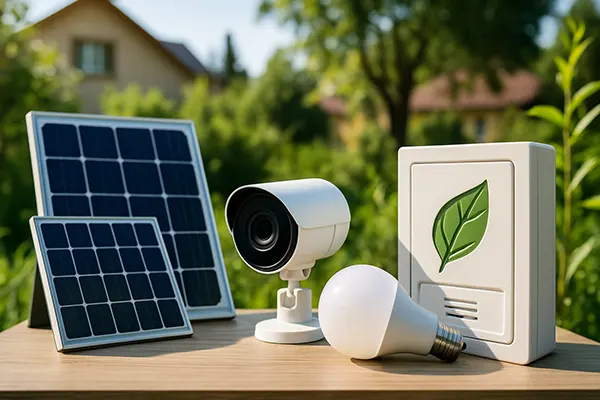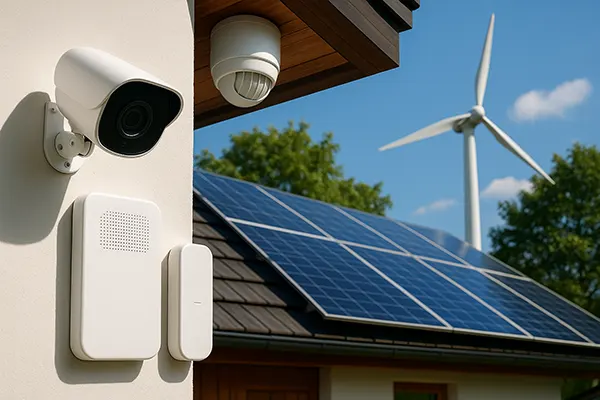Modern security systems are no longer evaluated only through the prism of reliability and incident prevention. By 2025, environmental responsibility has become a key expectation, shaping how technologies are produced, installed and maintained within residential and commercial environments. This shift influences both regulatory approaches and consumer demand, accelerating the development of energy-efficient solutions and installation methods that minimise environmental impact.
Energy Efficiency in Contemporary Security Systems
Energy performance is one of the central benchmarks for assessing modern security solutions. The growing use of low-voltage devices, cloud-connected controllers and advanced power management has significantly reduced electricity consumption while improving operational stability. Manufacturers integrate energy-saving protocols capable of coordinating sensor behaviour depending on occupancy levels, lighting conditions or scheduled routines.
Battery-powered devices have also evolved. Smart battery analytics now prevent premature disposal by providing accurate charge predictions and optimised charging cycles, which extend the lifespan of components. Many systems rely on rechargeable lithium-iron-phosphate batteries, considered safer and more environmentally stable compared with traditional lithium-ion units. The improved durability lowers waste generation and reduces the number of replacements throughout the system’s life cycle.
Solar-assisted security technologies continue to expand in residential areas. Solar-integrated CCTV towers, autonomous perimeter sensors and photovoltaic-powered access units ensure functionality even during power interruptions. For properties in remote locations, these off-grid options allow reliable operation without dependence on conventional electricity supply, supporting a long-term reduction of carbon emissions.
Smart Power Management and Environmental Benefits
Power optimisation algorithms help security systems adjust to changing interior and exterior conditions. Motion-controlled cameras can automatically switch between active and standby states, while alarm panels regulate energy distribution to sensors based on real-time priorities. This reduces electricity waste and ensures that high-consumption components operate only when genuinely required.
Smart meters integrated with home energy-management hubs allow residents to monitor the power usage of their security infrastructure. This creates transparency and helps households align system operation with sustainability targets. The ability to schedule device activity—such as night-mode activation or temporary deactivation while residents are away—further enhances efficiency.
On a wider scale, energy-efficient security infrastructures reduce resource load on residential blocks and modern housing developments. As more regions adopt regulations promoting near-zero-energy buildings, low-consumption security systems contribute to meeting these standards. Developers increasingly showcase eco-optimised alarm and monitoring solutions as part of their sustainable construction strategy.
Sustainable Installation Practices
Environmentally aware installation methods are becoming a standard expectation for contractors and system designers. Techniques that reduce material waste—such as optimal cable routing, modular mounting, and the use of recyclable hardware—play a decisive role in lowering environmental impact. Installers are actively switching to halogen-free cabling, which improves fire safety and minimises the release of harmful substances.
The transition towards wireless solutions also significantly reduces the need for invasive structural alterations. With mesh-network sensors and wireless alarm components, installers eliminate the need for extensive drilling or cable conduits. This contributes not only to quicker installation but also to a lower environmental footprint for new and renovated properties.
Responsible disposal of legacy equipment remains a major requirement. Certified recycling programmes for cameras, sensors and control panels help prevent electronic waste from entering landfills. Many manufacturers now operate take-back schemes, accepting outdated units for proper processing, ensuring that rare metals and plastics are recovered and reused.
Materials, Durability and Environmental Compliance
Long-lasting materials reduce the frequency of replacements, supporting a more sustainable system lifecycle. Housing shells made from recycled plastics, stainless steel or aluminium alloys offer improved weather resistance and reduce reliance on virgin raw materials. For outdoor installations, corrosion-resistant materials help maintain system performance without requiring environmentally harmful protective coatings.
Environmental certifications such as RoHS, REACH and ISO 14001 guide manufacturers in selecting safer components. By following these standards, security systems contain fewer hazardous elements, making them safer to install, maintain and recycle. Products that meet strict compliance criteria are increasingly preferred in both residential and public developments.
The rise of modular architecture also contributes to sustainability. Devices are designed so that damaged components can be replaced individually without discarding the entire unit. This approach extends system lifespan and reduces the volume of electronic waste generated by maintenance procedures.

Integration with Modern Housing Standards
Across Europe, housing standards now emphasise the environmental impact of all building technologies, including security infrastructures. Energy-performance directives and local planning regulations encourage the use of low-consumption systems that align with the sustainability goals of residential developments. Smart home integrations ensure that security components complement wider energy-saving strategies.
In contemporary housing, security equipment forms part of the broader digital ecosystem. Devices communicate with ventilation, lighting and heating systems, allowing households to manage safety and energy flows with greater precision. When combined with occupancy sensors, these connections help optimise building performance without increasing environmental load.
Developers are increasingly required to document the environmental performance of installed systems. The inclusion of efficient alarms, smart locks and video surveillance supports compliance with green construction frameworks, such as BREEAM or national energy-efficiency directives. As a result, eco-optimised security technology has become a fundamental characteristic of modern sustainable housing.
Long-Term Impact on Residential Environments
Environmentally conscious security systems contribute to healthier living spaces by limiting noise, emissions and unnecessary energy use. Cameras with adaptive brightness control reduce light pollution, particularly in densely populated areas. Silent alarm components and low-energy standby modes further improve residential comfort.
Smart diagnostics help maintain system performance without frequent in-person inspections. Remote maintenance tools identify issues early, reducing travel emissions associated with technician visits. This supports a more sustainable service model while ensuring high system reliability.
Over time, the adoption of eco-efficient security solutions strengthens the resilience of residential infrastructure. Buildings become less dependent on traditional power networks, and homeowners benefit from stable, environmentally conscious technologies that integrate seamlessly with future housing developments.



